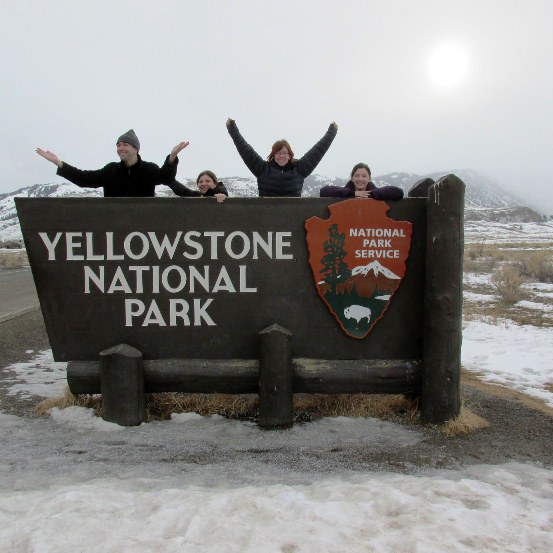
Archives Blitz Team 4 participants enjoying Yellowstone, January 2015.
As I boarded my flight in Detroit, Michigan to head out to the Heritage and Research Center in Yellowstone National Park, I was elated to be part of the innovative Archives Blitz project. I was also a bit terrified. First, I was elated because I was chosen to process records at Yellowstone National Park. Second, I would be applying MPLP (More Product, Less Process), a concept I had read about in graduate school but had never implemented in the real world. And last, I was elated to be gaining archival processing experience from such a fabulous scientific research facility. But I was also terrified because as a recent graduate in archival studies I lacked the experience of putting principles into practice. And not only was I going to be processing archival records for America’s first National Park, but I would be expected to do so in a very amplified manner: the Archives Blitz approach is archival processing on steroids. Finally, the thought crossed my mind, who goes to Montana in January? Only the foolhardy and courageous. Turns out I am both.
Here’s what happened.
On day one we walked into a room with approximately three hundred and fifty linear feet of administrative files. Our job as a Blitz team was to identify records and papers of enduring value and make them available to researchers. Was it possible to gain physical and intellectual control over this record group in one week’s time? We were about to find out.
As quickly and efficiently as possible we surveyed the materials for sufficient value to justify the cost of storage, arrangement, description, and preservation. Such decisions are difficult because all records have some conceivable value. There are always a multitude of people who will find a use for a certain record. The park’s archivist, Anne Foster, gave me these gems of Blitz wisdom that I kept in the forefront of my mind while processing: Does the record reflect the function of the organization? And, do the materials have potential research value? I admit I felt a significant responsibility to assume what may be of interest to future researchers. However, keeping Anne’s questions and the MPLP concept in mind, I moved through the folders in semi-lightning speed.
After sorting the collection into series we assigned each series to an Archives Blitz team member. My series: Occupational Safety. The materials in my group related to all aspects of the park’s safety policies and procedures. By the end of the week I had established the types of materials, inclusive and bulk dates, important divisions, and significant correspondence and subjects within my series and arranged them chronically within the folders.
At the end of the week I was feeling good about the work I had done. The Archives Blitz approach is an innovative concept that could expedite getting collection materials into the hands of users. Utilizing MPLP allows for more arrangement of materials that are adequate to user needs and sufficiently described to promote use. It’s better to have more collections that are available to users even if they are processed at the minimal level than have a small number of ideally processed collections.
What I didn’t expect to happen and what no one told me was that I would not be the same person I was when I arrived in Gardiner, Montana. Yellowstone in winter is magical. Steam rises from the snow covered landscape and in the quiet dawn of morning I am humbled by its stunning beauty and mystery. Animal tracks weave in and out of snowy meadows, mineral pools in otherworldly shades of blue give off mists, and a spectacular canopy of stars explode overhead in the crisp, cold air of January. A different kind of quiet takes over. The cracking consciousness of a culturally and historically rich place like Yellowstone forced me to come into contact with something I had been ignoring for a while now. That something was myself. I felt like Alice in a geothermal Wonderland. Surrounded by endless sky and towering mountains, I was in a strange land. Free from the artificial and apart from human constructions, these remaining pockets of wilderness hold our deep evolutionary history. Without wild-ness our psychic as well as our physical sustenance is at stake. So thank god for wild places. All that wild beauty reflecting back at me strengthened my responsibility to the land, to preserving historically and culturally significant items for future generations; whether in the archives or in the landscape, we have a responsibility to care for items of enduring value. Records and wilderness depend on us.

Boiling River, January 2015 (Photo by Jen Schultz).
